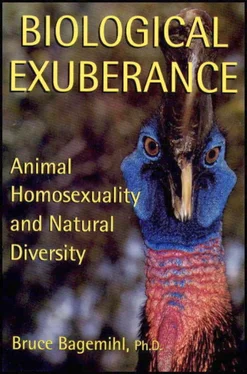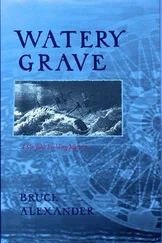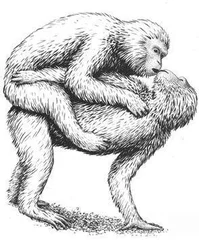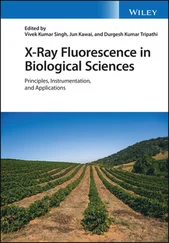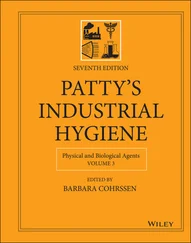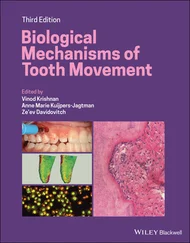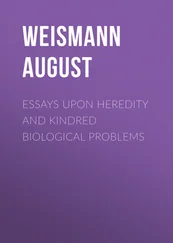124
Hausfater, G., and S. B. Hrdy, eds. (1984) Infanticide: Comparative and Evolutionary Perspective (New York: Aldine Press).
125
This strategy is also sometimes employed by females: see Acorn Woodpecker, Little Egret; and Ichikawa, N. (1995) “Male Counterstrategy Against Infanticide of the Female Giant Water Bug Lethocerus deyrollei (Hemiptera: Belostomatidae),” Journal of Insect Behavior 8:181-88; Stephens, M. L. (1982) “Mate Takeover and Possible Infanticide by a Female Northern Jacana ( Jacana spinosa )” Animal Behavior 30:1253-54.
126
Hoagland, J. L. (1995) The Black-tailed Prairie Dog: Social Life of a Burrowing Mammal (Chicago: University of Chicago Press). For further discussion of the often neglected topic of female infanticide, see Digby, L. (1995) “Infant Care, Infanticide, and Female Reproductive Strategies in Polygynous Groups of Common Marmosets ( Callithrix jacchus ),” Behavioral Ecology and Sociobiology 37:51-61; Digby, L., M. Y Merrill, and E. T. Davis (1997) “Infanticide by Female Mammals. Part I: Primates,” American Journal of Primatology 42:105.
127
For general surveys of cannibalism among animals, see Elgar, M. A., and B. J. Crespi, eds. (1992) Cannibalism: Ecology and Evolution Among Diverse Taxa (Oxford: Oxford University Press); Jones, J. S. (1982) “Of Cannibals and Kin,” Nature 299:202-3; Polis, G. (1981) “The Evolution and Dynamics of Intraspecific Predation,” Annual Review of Ecology and Systematics 12:225-51; Fox, L. R. (1975) Cannibalism in Natural Populations,” Annual Review of Ecology and Systematics 6:87-106.
128
Daly, M., and M. I. Wilson (1981) “Abuse and Neglect of Children in Evolutionary Perspective,” in R. D. Alexander and D. W. Tinkle, eds., Natural Selection and Social Behavior: Recent Research and New Theory , pp. 405—16 (New York: Chiron Press); Reite, M., and N.G. Caine, eds., (1983) Child Abuse: The Nonhuman Primate Data . Monographs in Primatology, vol.1 (New York: Alan R. Liss); Székely et al., “An Evolutionary Approach to Offspring Desertion in Birds.”
129
Stoleson, S. H., and S. R. Beissinger (1995) “Hatching Asynchrony and the Onset of Incubation in Birds, Revisited: When Is the Critical Period?” in D. M. Power, ed., Current Ornithology, vol. 12, pp. 191-270 (New York: Plenum Press); Evans, R. M., and S. C. Lee (1991) “Terminal-Egg Neglect: Brood Reduction Strategy or Cost of Asynchronous Hatching?” Acta XX Congressus Internationalis Ornithologici (Proceedings of the 20th International Ornithological Congress, Christchurch, New Zealand), vol. 3, pp. 1734—40 (Wellington, NZ: New Zealand Ornithological Trust Board); Mock, D. W. (1984) “Siblicidal Aggression and Resource Monopolization in Birds,” Science 225:731—32; O‘Connor, R. J. (1978) “Brood Reduction in Birds: Selection for Fratricide, Infanticide, or Suicide?” Animal Behavior 26:79-96.
130
Skeel and Mallory (1996) “Whimbrel ( Numenius phaerops )” in A. Poole and F. Gill, eds., The Birds of North America: Life Histories for the 21st Century, no. 219, p. 17 (Philadelphia: Academy of Natural Sciences; Washington, D.C.: American Ornithologists’ Union); Skutch, A. F. (1976) Parent Birds and Their Young, pp. 349-50 (Austin: University of Texas Press); Anthonisen, K., C. Krokene, and J. T. Lifjeld (1997) “Brood Division Is Associated with Fledgling Dispersion in the Bluethroat ( Luscinia s . svecica ),” Auk 114:553—61; Székely et al., “An Evolutionary Approach to Offspring Desertion in Birds,” pp. 275-76.
131
See discussion on p. 171 and the references in note 7 (this chapter).
132
Pierotti and Murphy 1987 (Western Gull/Kittiwake); Redondo, T., E S. Tortosa, and L. A. de Reyna (1995) “Nest Switching and Alloparental Care in Colonial White Storks,” Animal Behavior 49:1097—110; Tella, J. L., M. G. Forero, J. A. Donázar, J. J. Negro, and F. Hiraldo (1997) “Non-Adaptive Adoptions of Nestlings in the Colonial Lesser Kestrel: Proximate Causes and Fitness Consequences,” Behavioral Ecology and Sociobiology 40:253-60. For egg transfer with adoption, see Black-billed Magpie, Caspian Tern, Cliff Swallow; for egg transfer through swallowing and regurgitation, see Vermeer, K. (1967) “Foreign Eggs in Nests of California Gulls,” Wilson Bulletin 79:341; for a case of egg transfer that does not necessarily involve adoption, see Truslow, F. K. (1967) “Egg-Carrying by the Pileated Woodpecker,” Living Bird 6:227-36.
133
For further examples of animals caring for offspring other than their own, see the index and the following articles: Riedman, M. L. (1982) “The Evolution of Alloparental Care and Adoption in Mammals and Birds,” Quarterly Review of Biology 57:405-35; Lank, D. B., M. A. Bousfield, F. Cooke, and R. F. Rockwell (1991) “Why Do Snow Geese Adopt Eggs?” Behavioral Ecology and Sociobiology 2:181-87; Andersson, M. (1984) “Brood Parasitism Within Species,” in C. J. Barnard, ed., Producers and Scroungers: Strategies of Exploitation and Parasitism , pp. 195-228 (London: Croom Helm); Yom-Tov, Y. (1980) “Intraspecific Nest Parasitism in Birds,” Biological Reviews 55:93-108; Quiatt, D. (1979) “Aunts and Mothers: Adaptive Implications of Allo-maternal Behavior of Nonhuman Primates,” American Anthropologist 81:310-19; Packer, C., S. Lewis, and A. Pusey (1992) “A Comparative Analysis of Non-Offspring Nursing,” Animal Behavior 43:265-81; Solomon and French, Cooperative Breeding in Mammals , especially pp. 335-63.
134
For surveys of various types of mating systems, see Rowland, R. (1966) Comparative Biology of Reproduction in Mammals (Orlando: Academic Press); Slater, P. J. B., and T. R. Halliday, eds. (1994) Behavior and Evolution (Cambridge: Cambridge University Press); Clutton-Brock, T. G. (1989) “Mammalian Mating Systems,” Proceedings of the Royal Society of London , Series B 235:339-72.
135
See, for example, Palombit (1994a,b, 1996), especially with regard to reevaluating the nature and diversity of pair-bonding, fidelity, and monogamy in Gibbons. It should also be pointed out that because the occurrence of infidelity between pair-bonded partners has only been appreciated relatively recently, the term monogamy is often used in the zoological literature simply as a synonym for pair-bonding .
136
Monogamy (absolute, or near absolute): Gyllensten, U. B., S. Jakobsson, and H. Temrin (1990) “No Evidence for Illegitimate Young in Monogamous and Polygynous Warblers,” Nature 343:168—70; Holthuijzen, A. M. A. (1992) “Frequency and Timing of Copulations in the Prairie Falcon,” Wilson Bulletin 104:333-38; Decker, M. D., P. G. Parker, D. J. Minchella, and K. N. Rabenold (1993) “Monogamy in Black Vultures: Genetic Evidence from DNA Fingerprinting,” Behavioral Ecology 4:29-35; Vincent, A. C. J., and L. M. Sadler (1995) “Faithful Pair Bonds in Wild Seahorses, Hippocampus whitei ,” Animal Behavior 50:1557—69; Mauck, R. A., T. A. Waite, and P. G. Parker (1995) “Monogamy in Leach’s Storm-Petrel: DNA-Fingerprinting Evidence,” Auk 112:473— 82; Haydock, J., P. G. Parker, and K. N. Rabenold (1996) “Extra-Pair Paternity Uncommon in the Cooperatively Breeding Bicolored Wren,” Behavioral Ecology and Sociobiology 38:1—16; Fleischer, R. C., C. L. Tarr, E. S. Morton, A. Sangmeister, and K. C. Derrickson (1997) “Mating System of the Dusky Antbird, a Tropical Passerine, as Assessed by DNA Fingerprinting,” Condor 99:512—14; Piper, W. H., D. C. Evers, M.W. Meyer, K. B. Tischler, J. D. Kaplan, and R. C. Fleischer (1997) “Genetic Monogamy in the Common Loon ( Gavia immer ),” Behavioral Ecology and Sociobiology 41:25-31; Kleiman, D. G. (1977) “Monogamy in Mammals,” Quarterly Review of Biology 52:39—69; Foltz, D.W (1981) “Genetic Evidence for Long-Term Monogamy in a Small Rodent, Peromyscus polionotus,” American Naturalist 117:665-75; Ribble, D. O. (1991) “The Monogamous Mating System of Peromyscus californicus As Revealed by DNA Fingerprinting,” Behavioral Ecology and Sociobiology 29:161—66; Brotherton, P. N. M., J. M. Pemberton, P. E. Komers, and G. Malarky (1997) “Genetic and Behavioral Evidence of Monogamy in a Mammal, Kirk’s Dik-dik ( Madoqua kirkii ),” Proceedings of the Royal Society of London , Series B 264:675-81. Infidelity or nonmonogamy: Gladstone, D. E. (1979) “Promiscuity in Monogamous Colonial Birds,” American Naturalist 114:545-57; Gowaty, P. A., and D. W. Mock, eds., (1985) Avian Monogamy (Washington, D.C.: American Ornithologists’ Union); Birkhead, T. R., L. Atkin, and A. P. Møller (1986) “Copulation Behavior of Birds,” Behavior 101:101-38; Westneat, D. E, P.W. Sherman, and M. L. Morton (1990) “The Ecology and Evolution of Extra-pair Copulations in Birds,” Current Ornithology 7:331-69; Black, J. M., ed. (1996) Partnerships in Birds: The Study of Monogamy (Oxford: Oxford University Press); Richardson, P. R. K. (1987) “Aardwolf Mating System: Overt Cuckoldry in an Apparently Monogamous Mammal,” South African Journal of Science 83:405-10; Palombit 1994a,b (Gibbons); Sillero-Zubiri, C, D. Gottelli, and D. W. Macdonald (1996) “Male Philopatry, Extra-Pack Copulations, and Inbreeding Avoidance in Ethiopian Wolves ( Canis simensis ),” Behavioral Ecology and Sociobiology 38:331-40.
Читать дальше
